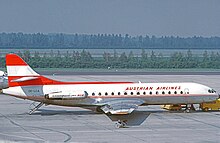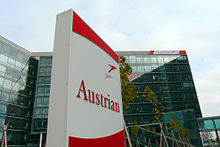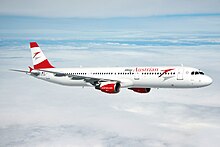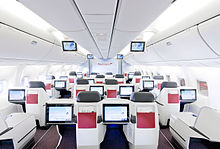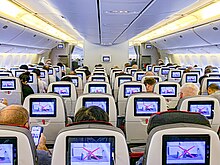Austrian Airlines
As of July 2016, the airline flew to six domestic and more than 120 international year-round and seasonal destinations in 55 countries[6] and is a member of the Star Alliance.
Throughout the 1990s, the airline sought out new strategic alliances, as well as to expand its presence in the long-haul market, launching new services to China and South Africa.
Following its privatisation, the business restructured, enacting both fleet expansion and cost-saving initiatives; visible changes included route alterations, a new corporate design, and a revised aircraft livery.
A new labour agreement led to the transfer of all flights back to Austrian Airlines on 1 April 2015, and the merger of Tyrolean Airways into its parent company.
The two companies jointly planned and operated line connections and created a route network to Berlin, Budapest, and Milan.
[10] In 1938, the company began planning routes to Rome, Paris, and London, using a fleet of Junkers Ju 90 aircraft.
[9] In 1955, two distinct companies, Air Austria and Austrian Airways, swiftly emerged to address this unoccupied market.
[10] On 30 September 1957, the new entity commenced operations, performing its maiden flight on 31 March 1958 when a leased Vickers Viscount 779 took off from Vienna for a scheduled service to Zürich and London.
[9] During early 1960, six new-build Viscount 837s were delivered to Austrian Airlines; unlike earlier aircraft, which had been leased, these were owned by the company and quickly displaced the former.
[11] During 1969, the airline broke new ground with the launch of its first long-distance route to New York City in the United States (early flights were made in co-operation with Belgian Sabena with a layover in Brussels).
[citation needed] On 26 March 1989, Austrian Airlines inaugurated its first regular long-haul route, to New York-JFK, using an Airbus A310-300 (OE-LAA), aptly named “New York”.
This was also a period of quick expansion in the long-haul market, launching new flight paths to China and South Africa.
Austrian Airlines cancelled several long-haul destinations, including Sydney via Kuala Lumpur, Melbourne via Singapore, Kathmandu, and Shanghai.
[18] AUA CEO Alfred Ötsch and OIAG chairman Peter Michaelis were heavily criticised for revealing to Lufthansa that it had to take over the €500 million debt only when the deal had been made binding.
Michaelis refused a new tendering procedure but was made a scapegoat with his shareholder rights removed,[19] and Ötsch resigned on 29 January 2013.
[20] The European Commission began an investigation into the acquisition on 1 July 2009, suspecting a fraudulent tendering process that had already determined everything in favour of Lufthansa.
[citation needed] The completion of extension works at the Vienna International Airport will give the airline more room for expansion.
[citation needed] Despite eliminating 2,500 jobs, the company was still losing money in December 2011, prompting the revelation of a new cost-saving plan.
[30] In April 2013, Austrian Airlines retired its final Boeing 737, a 737-800 variant in Lauda Air markings, as part of its fleet consolidation exercise.
[10] The airline's 11 Boeing 737s were replaced by seven Airbus A320s; it was reportedly expected to achieve annual saving of €17 million through the move to a single type.
[10] Due to increasing competition from low-cost carriers at its Vienna base and the need to streamline operations to avoid financial losses, the airline announced restructuring its fleet and network in 2019.
[41] From 18 March to 15 June 2020, Austrian Airlines officially suspended all the regularly scheduled flights as the global air traffic collapsed due to the COVID-19 pandemic.
In October of the same year, Austrian welcomed the first of the four new Airbus A320neo into the fleet, with the remaining three slated for gradual introduction until spring 2023.
[50][51] In early 2024, Austrian confirmed that the airline will now receive overall 11 Boeing 787-9s, of which two pre-owned by Bamboo Airways will be delivered by March 2024[52] with a start of scheduled operations planned for summer 2024.
[54] In January 2025, Austrian announced it would retire its three remaining Boeing 767-300ER in the same year, with the last scheduled route being Vienna-Washington D. C., by 31 December 2025.
Since 2003, the new corporate design has reintroduced the old "Chevron" shape in a more modern style, incorporating a drop shadow underneath.
[75] Austrian Airlines temporarily restarted the Vienna to Sydney route in March 2020 as part of their repatriation flights to retrieve people stranded in other countries during the COVID-19 pandemic.
The flight from Vienna to Sydney was direct, whereas the return trip stopped in Penang, Malaysia, for refuelling and to take on extra cargo.
[84] Austrian Airlines commenced service to Los Angeles on 10 April 2017, covering a distance of over 9,877 kilometers or 6,137 miles; the flight takes about 12 hours and 30 minutes, using Boeing 777-200ER aircraft.
[85] Austrian Airlines announced it would commence service (four times a week) to Shiraz which began on 2 July 2017, with a stopover in Isfahan using Airbus A320 aircraft.



